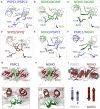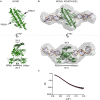Structural basis of dimerization and nucleic acid binding of human DBHS proteins NONO and PSPC1
- PMID: 34904671
- PMCID: PMC8754649
- DOI: 10.1093/nar/gkab1216
Structural basis of dimerization and nucleic acid binding of human DBHS proteins NONO and PSPC1
Abstract
The Drosophila behaviour/human splicing (DBHS) proteins are a family of RNA/DNA binding cofactors liable for a range of cellular processes. DBHS proteins include the non-POU domain-containing octamer-binding protein (NONO) and paraspeckle protein component 1 (PSPC1), proteins capable of forming combinatorial dimers. Here, we describe the crystal structures of the human NONO and PSPC1 homodimers, representing uncharacterized DBHS dimerization states. The structures reveal a set of conserved contacts and structural plasticity within the dimerization interface that provide a rationale for dimer selectivity between DBHS paralogues. In addition, solution X-ray scattering and accompanying biochemical experiments describe a mechanism of cooperative RNA recognition by the NONO homodimer. Nucleic acid binding is reliant on RRM1, and appears to be affected by the orientation of RRM1, influenced by a newly identified 'β-clasp' structure. Our structures shed light on the molecular determinants for DBHS homo- and heterodimerization and provide a basis for understanding how DBHS proteins cooperatively recognize a broad spectrum of RNA targets.
© The Author(s) 2021. Published by Oxford University Press on behalf of Nucleic Acids Research.
Figures






References
-
- Zhu Z., Zhao X., Zhao L., Yang H., Liu L., Li J., Wu J., Yang F., Huang G., Liu J.. p54/NONO regulates lipid metabolism and breast cancer growth through SREBP-1A. Oncogene. 2016; 35:1399–1410. - PubMed
Publication types
MeSH terms
Substances
LinkOut - more resources
Full Text Sources
Miscellaneous

